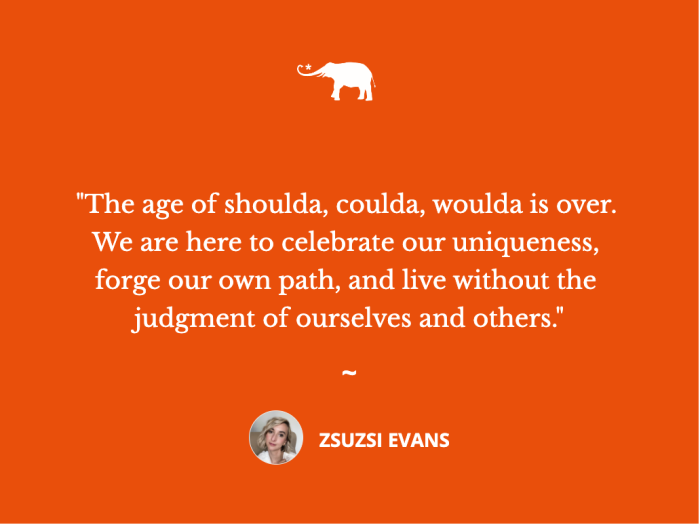According to Grammarly, the definition of a sunk cost fallacy is “a logical fallacy that entails sticking with a losing or failed venture because you’ve already invested a significant amount of time, money, or other resources that you can’t get back (Kramer, 2022, para. 3).” While this sounds like it applies only to financial investments, I believe this also applies to our everyday lives. People stay in situations that are no longer serving them because they don’t want to create upheaval. They push aside their own needs for many years until they feel like a stranger to themselves. Then one day they may wake up and realize that they don’t want this anymore, but according to the sunk cost fallacy, it’s too late.
A great awakening is happening on this planet. You could say it started in 2020 as a result of an unprecedented pause we were all forced to take. Many people realized they could no longer look away from the reality that they were not satisfied with how they were living. But what was there to do? Most of the situations we found ourselves in, did not happen overnight. They were the product of many years of studying, investing, working, and communicating. We were following the steps we believed it took to become successful, happy, and safe. But when we reached our goals (or even surpassed them) we still didn’t experience the contentment we were promised. It became time to reevaluate in a big way.
So why is it so hard to pivot? Our mind does not want to admit that we were “wrong.” We never want to feel like we’ve wasted our time or anyone else’s. And for a lot of us, our identity, our very existence, is wrapped up in this THING that we’ve invested in. Who are we without it and what is the next step? THIS is where Human Design can be a huge help.
My existential crisis started a few years before the pandemic. I found myself balls deep in debt because of a business I had started and was now miserably running. My marriage had turned into a sort of balancing act, oscillating between polite contempt and quiet suffering. I felt isolated, alone, and completely stuck. I had been a “good girl” for which I felt I was owed a reward of some kind. The participation trophy for being an obedient contributor to the Matrix. I needed a change, but I knew I had no idea where to start. Instead, I waited for a sign, and then Human Design hit me like a freight train.
My first reading happened by chance, and it was the most mind-bending thing I’ve ever experienced. I finally understood who I was without all the external stuff. The chart validated the way I interpreted life without making me feel like everything was all my fault. Even though it would take some time for my purpose and my role to become obvious to me, it was a very big step in the correct direction. I use the term “correct” and not “right” because I had always been going in what I believed was the right direction, and now I had the opportunity to see what was correct for ME!
Did my mind still get hung up in all the sunk cost fallacies of my college education, the many years I spent building my career and contacts, and the exorbitant amount of money I invested in my various trainings and business? Yes, it did. Was I worried what other people might think if I walked away from my marriage after only five years? You bet. But now I had a way to see why I chose all those things and why they never truly felt aligned. Not only that, but now I had a way to truly trust myself and a way to measure if a decision was correct for me. Nobody else has to live my life except for me! It became less and less possible to override my inner knowing and I started to make the changes necessary to create the life I wanted from scratch.
None of it happened overnight. It was a slow and steady, step-by-step process. But eventually my life started to put itself back together. I say that because I had very little to do with it. You see, according to Human Design we are here to surrender to our destiny instead of constantly chasing things and trying to “make things happen.” Do without doing, and everything gets done. Once I cleared space for the new things to come into my life, I became available for the magic to show up. It wasn’t what I expected, but it was exactly what I needed.
Age is another big concern in our sunk cost fallacy. We reach certain milestones and compare ourselves to our peers as if their timeline has anything to do with our own. If important boxes aren’t checked by a certain age, we feel we have failed somehow. According to Human Design, this is because we now live longer as a species. The timeline we still feel beholden to is that of a person whose average life expectancy was 35 years. We now live an average of 84 years and yet we still feel like life ends after 30 (especially if you’re younger than 30). We are here to thrive well beyond what we’ve been told. There is no use living from a deficit when we’re not even here to begin until 50.
So, to review, the psychology of our sunk cost fallacy theory is that when we follow a certain path and it doesn’t pan out, it’s too late because we invested so much time. If we’re in a relationship that isn’t satisfying, we should stick it out because of the energy invested, the children involved, or to avoid the judgment of others. And of course, all of this is compounded by the ever-looming thought that you’re not getting any younger. No wonder everything feels like a trap. But it doesn’t have to be. When you step out of this paradigm that keeps you in these situations, relationships, and timelines your life can truly be your own. You have an inner knowing, and all you must do is tap into its wisdom and power.
If this sounds vague, that’s because it is. I can’t tell you what this inner knowing is without showing you your unique chart and explaining your individual mechanics. Even after you understand your strategy and inner authority (the foundation of your inner compass) there are countless layers to peel away and understand about who you are. I can show you the way, but only you can teach yourself who you are by living it.
Like I said in the beginning of this article, the great awakening is here. Human Design confirms that we are not here to do anything like anybody else, EVER. For far too long we’ve allowed the fear of the sunk cost fallacy to hold us hostage in our own lives. The age of shoulda, coulda, woulda is over. We are here to celebrate our uniqueness, forge our own path, and live without the judgment of ourselves and others. Human Design is the permission slip we’ve been waiting for. It’s NEVER too late to start over.
Zsuzsi Evans is a Human Design Relationship Coach in Mount Shasta, CA. She has been featured on the Lit AF Podcast, the Rose Yoga Podcast, and as a keynote speaker at the High Desert Human Design conference. If you would like to get your free Human Design chart, visit her site here.
Kramer, Lindsay. “Sunk Cost Fallacy: Definition and Examples.” Grammarly. August 25, 2022. https://www.grammarly.com/blog/sunk-cost-fallacy/












Read 0 comments and reply